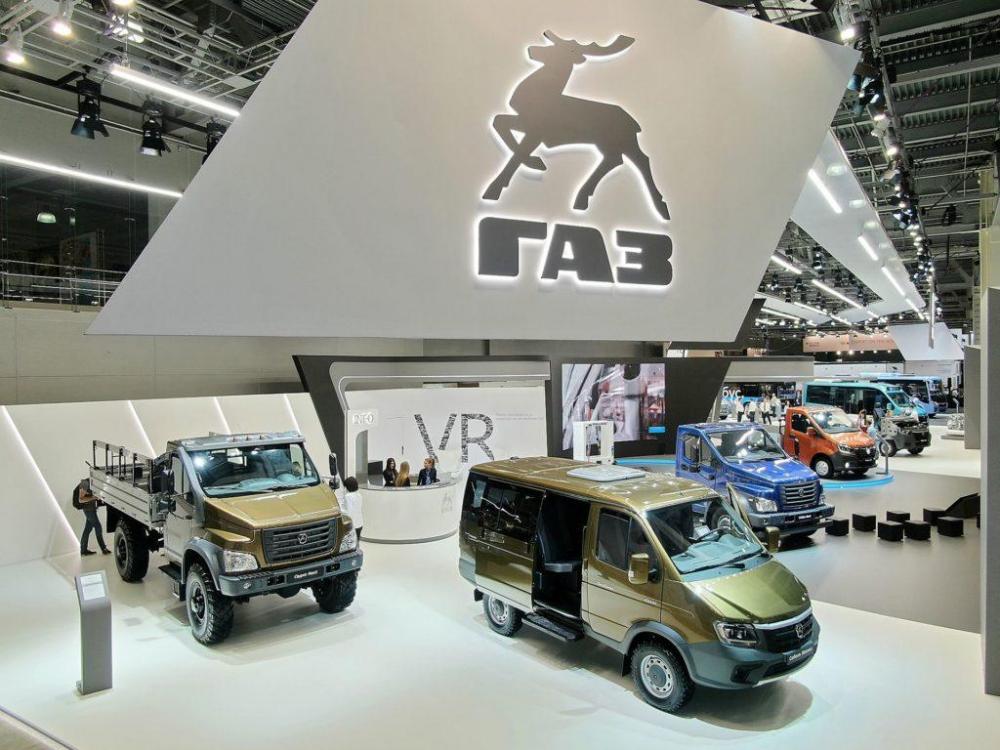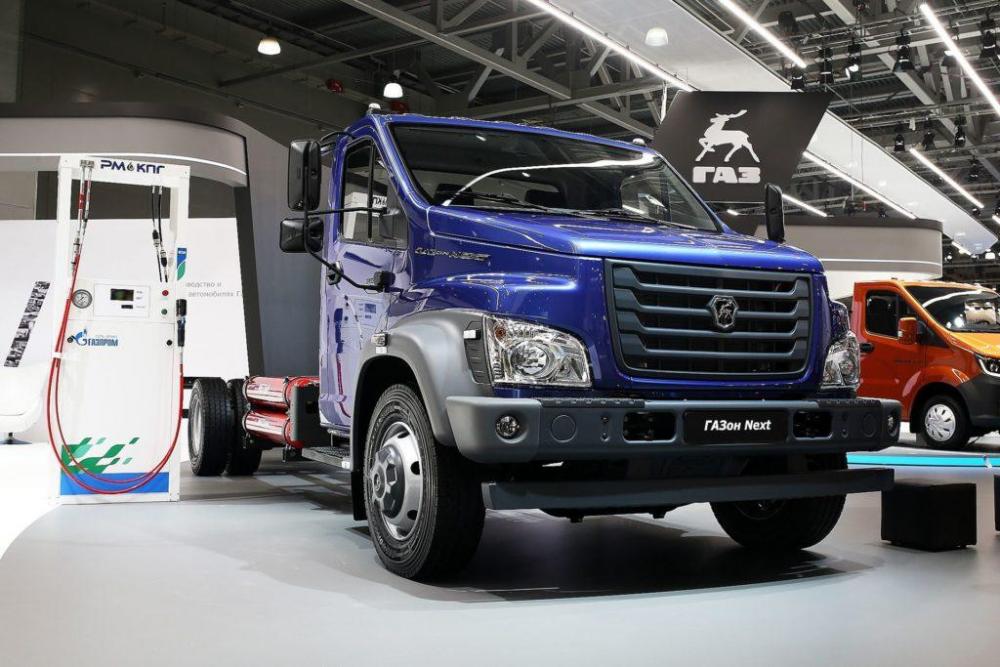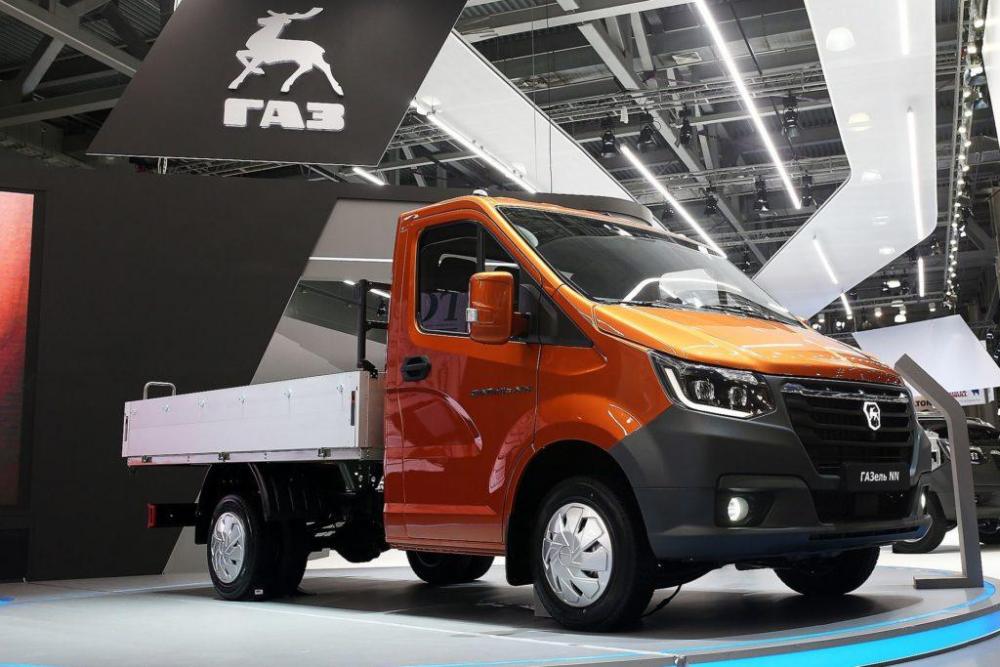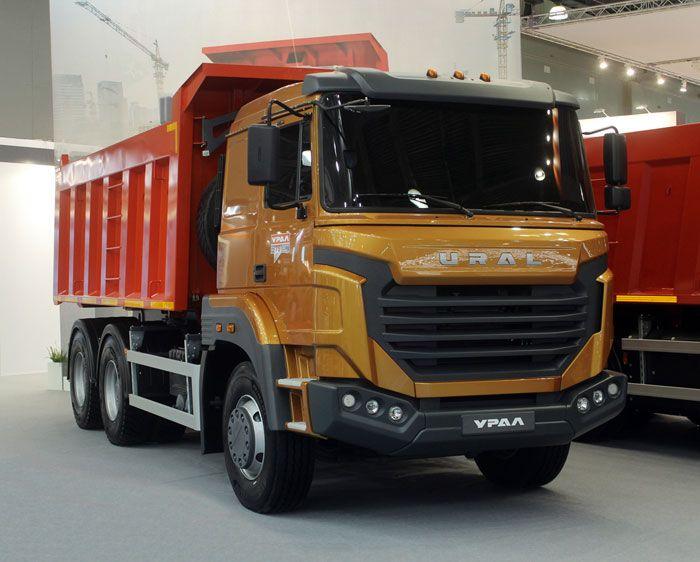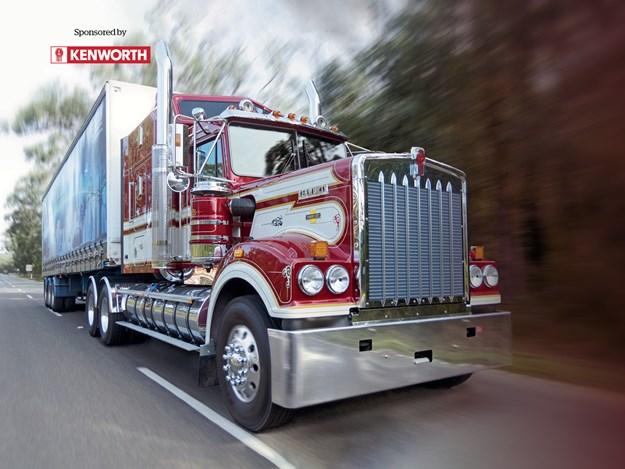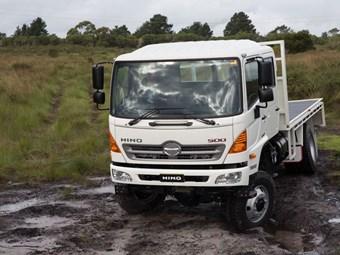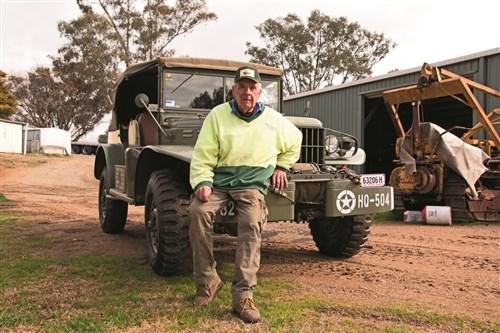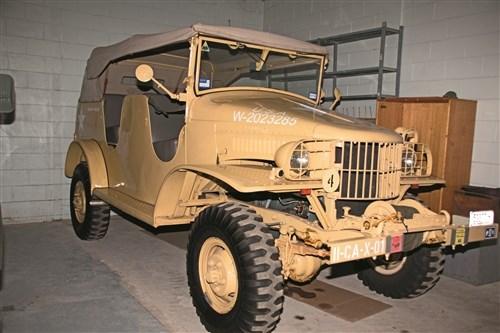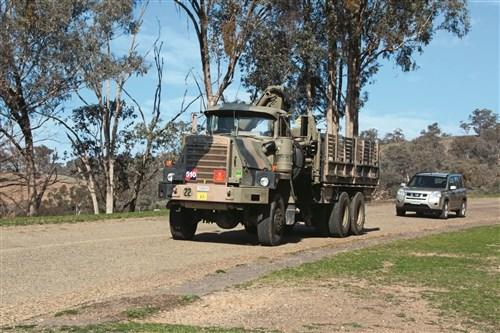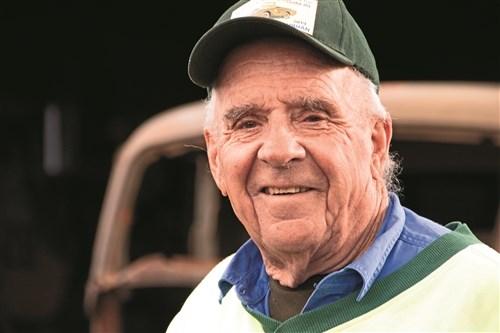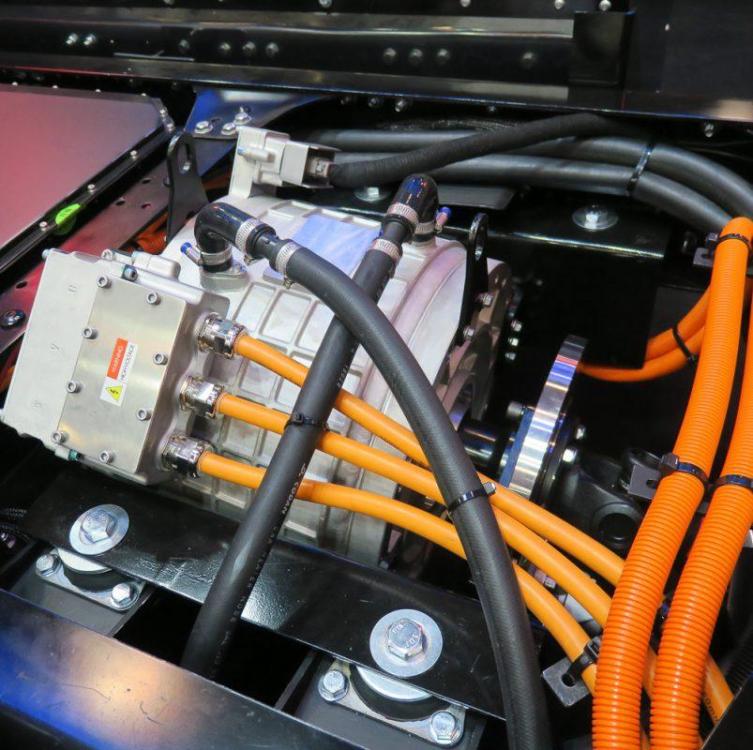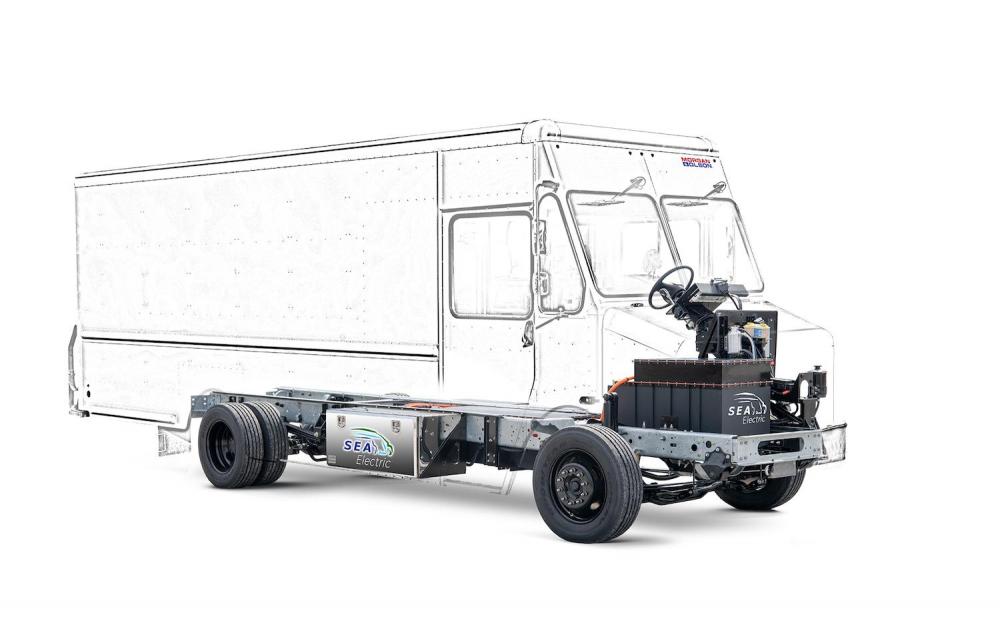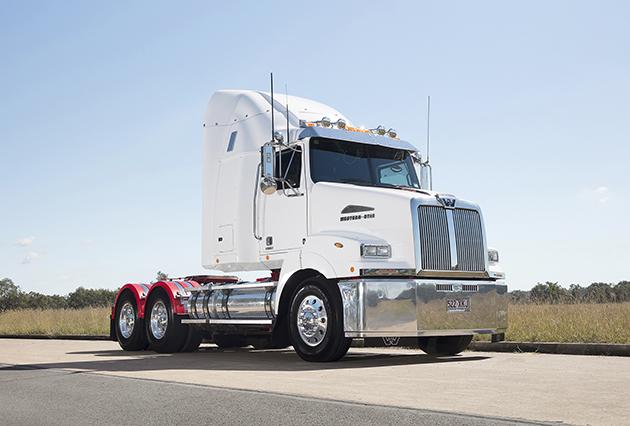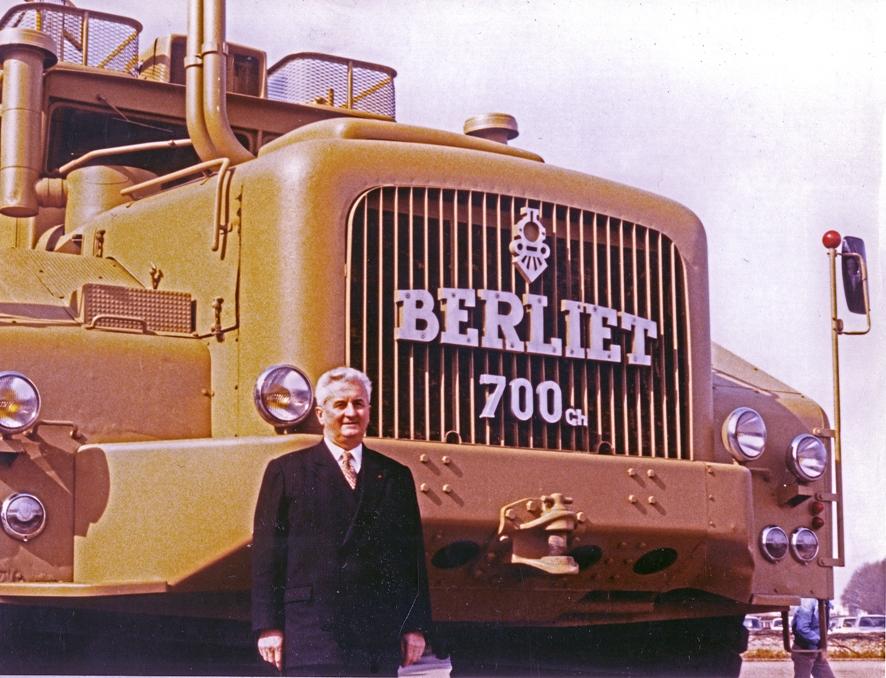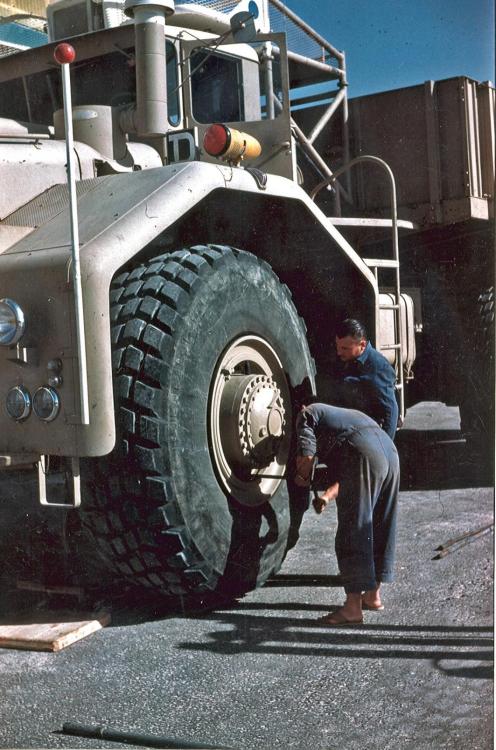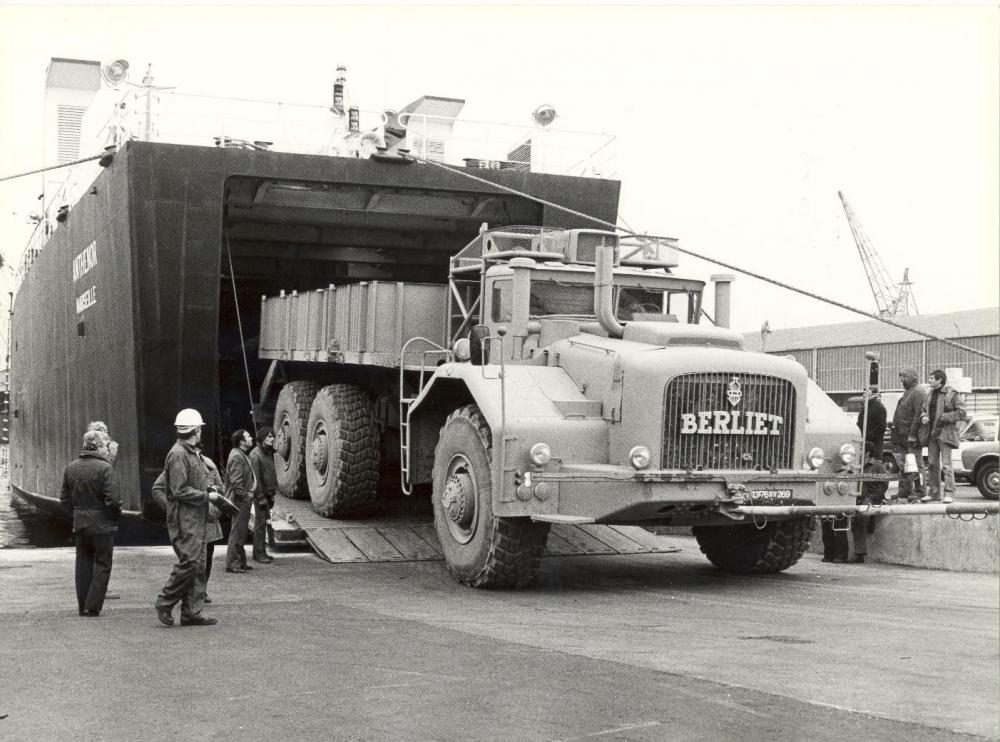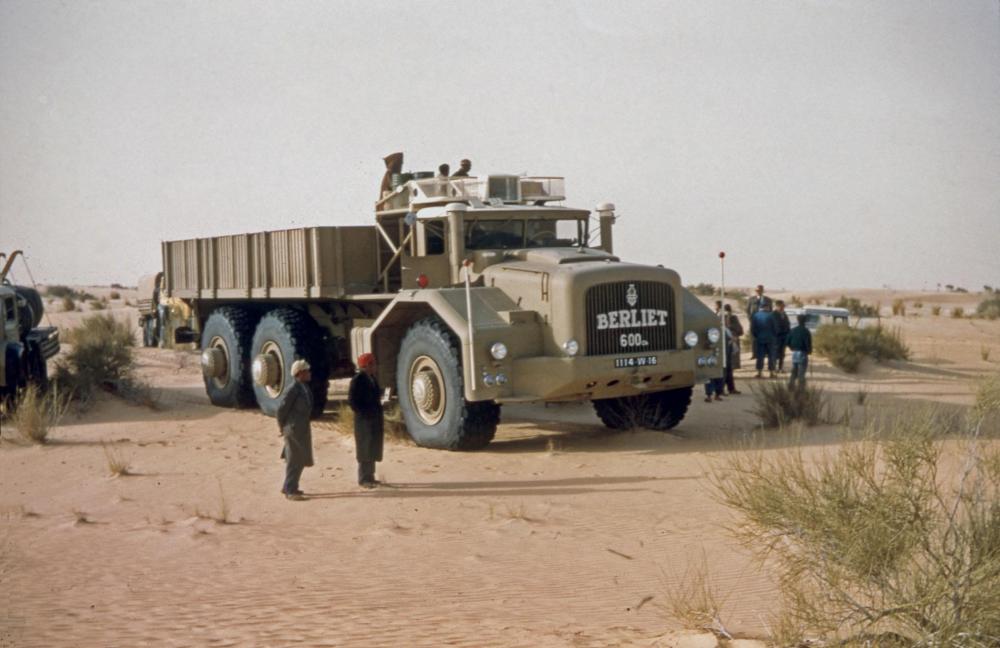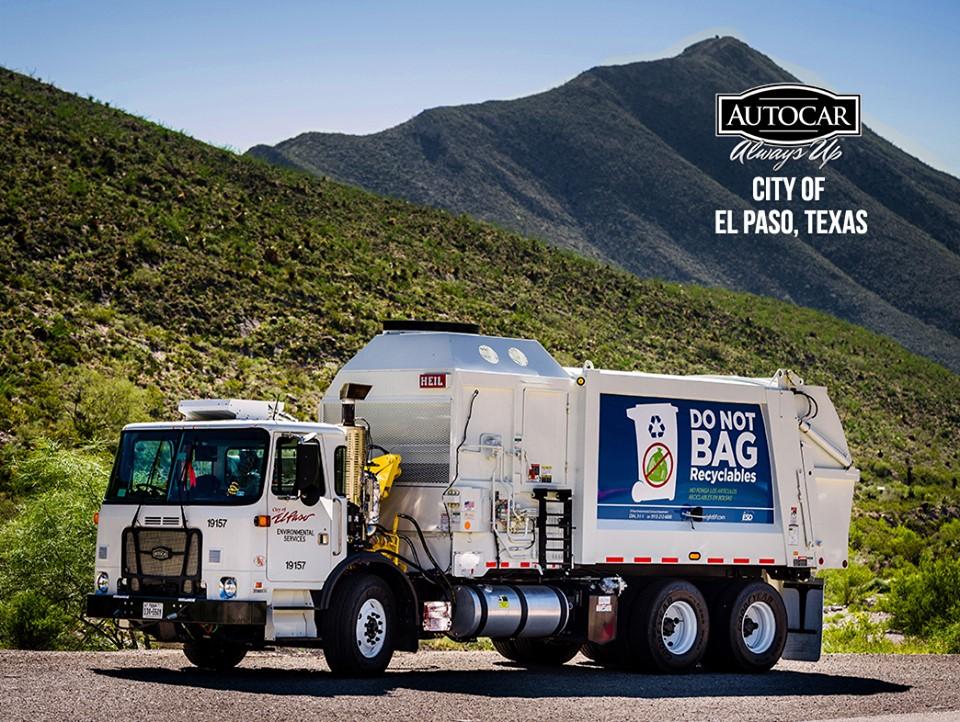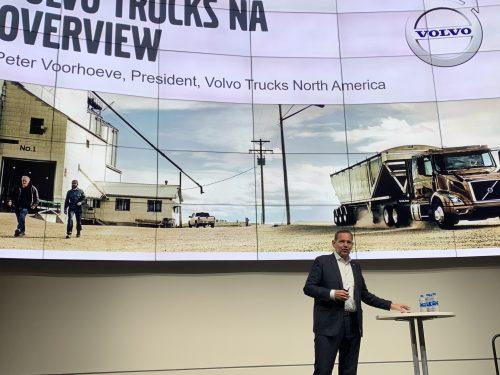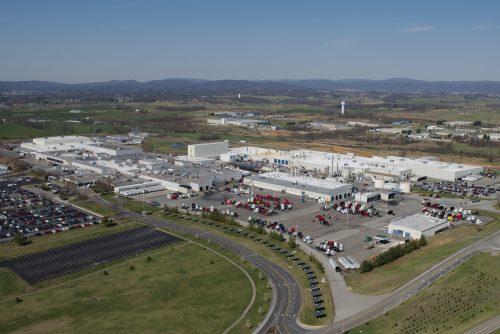
kscarbel2
Moderator-
Posts
18,541 -
Joined
-
Days Won
112
Content Type
Profiles
Forums
Gallery
Events
Blogs
BMT Wiki
Collections
Store
Everything posted by kscarbel2
-
Iepieleaks / September 6, 2019 At the COMTRANS 2019 exhibition GAZ Group presents a whole range of new models of light commercial vehicles, medium-duty trucks, buses and powertrains. The most notable new product unveiled at the exhibition is the new light commercial vehicle GAZelle NN developed by engineers of Gorky Automobile Plant in the year when the original GAZelle marked its 25th anniversary. Other new products include the Sadko Next off-road truck, the GAZon Next 10 running on two types of natural gas, and the upgraded Sobol 4×4. The bus range of the company is represented by the new low-floor minibus, the GAZ electric bus, the new Vector Next intercity bus and the GAZelle Next 4.6 CNG minibus. Also the GAZ Group booth features a Euro-6 diesel engine and Euro-5 gas engines based on the YMZ-530 engine family. The exhibition takes place on the premises of Crocus Expo from September 3 till September 7. The Sadko Next off-road truck represents a new generation of the iconic GAZ off-roaders. It combines a unique off-road capability with a high level of comfort, functionality and modern engineering solutions. The integrated steering together with a new front suspension with thin leaf springs provides good handling, smooth ride and stability. The fully pneumatic brake system ensures efficient braking requiring a little force on the brake pedal. A reinforced frame made of high-strength steel, a new driveline, wheels with upgraded disks and new tires with higher load rating, axles with new steering knuckles allowed increasing the vehicle’s payload capacity while retaining high reliability and durability of the design as a whole. The new Sadko features a spacious Next three-seater cab made of galvanized steel, the vehicle’s payload capacity has increased to 3 tons (for the chassis), the fordable depth is up to 1.2 m, and now the vehicle capable of towing a trailer with a gross weight of up to 2.56 tons. The GAZon Next 10 LNG/CNG is equipped with a combined transport system operating on two types of natural gas: LNG (liquefied natural gas) and CNG (compressed natural gas). With a comparable fuel tank capacity the LNG provides 3 times more range than the CNG. Therefore, such vehicles are most cost efficient for long daily runs. The range of a vehicle on a single tank of gas is 900 km. The GAZelle Next 4.6 CNG minibus is designed to carry 22 passengers (19 seats and 3 standing places). The bus features an upgraded gas/gasoline EvoTech 3.0. The engine displacement increased to 3 l and a number of other engineering changes allowed increasing the engine power output and torque, reducing the heat stress and increasing the stability of running at high temperatures. The use of compressed gas allows reducing fuel costs by 40-50% (depending on the mileage and features of a particular model) compared to gasoline and diesel fuel. The upgraded Sobol 4×4 off-road vehicle is characterized by an updated frontend styling, an upgraded front axle with CV joints, a new transfer case, an increased torque, electrically controlled. The new driver’s seat, a joystick gear shifter, as well as other engineering changes have significantly increased the vehicle’s level of comfort, reduced noise and vibration levels. The GAZ electric bus with ultrafast charging is an updated version of the new zero-emission vehicle. It was designed in cooperation with Bauman Moscow State Technical University based on the popular LIAZ-5292 low-floor city bus to offer the best value for money operation and maintenance. The GAZ electric can carry 85 passengers, including 30 seated passengers, and has a wheelchair area. The power plant of the bus complies with the international environmental standard Zero Emission, which is characterized by a complete absence of harmful emissions into the atmosphere. The bus features a kneeling system (allowing the driver to lower the front step height), a video surveillance system and a fire extinguishing system, USB-charging, an air conditioning system and GLONASS equipment. The demonstrated model has an improved driver’s compartment: the instrument panel features an LED display to output various diagnostics data. The YMZ-53426 Euro-6 diesel engine with a displacement of 4.43 l has optimal technical and economic parameters in terms of oil and fuel consumption, a power range of 170-210 hp, a torque of 664-780 Nm. .
-
Iepieleaks / September 5, 2019 Ural launched their new CP328P COE at the 2019 COMTRANS international commercial truck show in Moscow. This 6×4 truck has the YaMZ diesel engine with 328 Hp, has a payload of 16,5 ton and a very well known cab. Behind the rather modern looking front there is the old Iveco cab from the seventees. Still going strong in Russia! .
-
Steve Brooks, Trade Trucks Australia / September 2, 2019 Spawned in the shadows of the iconic W-model, it was perhaps inevitable Kenworth’s classic T900 would one day notch ‘Legend’ status. Yet embedded in this story of a remarkably resilient truck are the steely pride and fierce passions of people devout in the Kenworth creed: ‘Australian Made. World’s Best’. They live it. They breathe it. Right to the end Almost a decade into his long and laudable career as Kenworth’s first Australian managing director, Andrew Wright had been quick to react to the downturn. As he saw it, the economic signs were foreboding. With his bean-counter brain kicking into survival mode, retrenchments at the Bayswater (Vic) head office and factory came hard and fast. Everything depended on the factory’s ongoing viability and Wright was uncompromising in his determination to protect the future and avoid Kenworth becoming just another importer. Yet seemingly overnight, Kenworth, generally, and Wright, specifically, became pariahs as commentators and competitors publicly lambasted the cuts as corporate overkill. Cries of "too much, too soon" and "putting profit before people" were loud and long. As time would soon show, an astute Wright had simply seen the writing on the wall clearer than his contemporaries. In fact, as the extravagance and excesses of the ‘80s collapsed into the economic doldrums of a new decade, and truck sales continued to slip lower than a frog’s freckle, there were more than a few executives openly wishing they’d followed Wright’s lead and made the tough decisions sooner rather than hovering in vain hope of a quick recovery. Whether we had to have it or not is debateable, but this was certainly a recession that hung around far longer than anyone expected. Road transport was hammered particularly hard, and difficult decisions were forced on companies of all persuasions – especially those with significant investment in local manufacturing tailored almost entirely to the domestic market. Companies like Kenworth. In fact, things were so crook in the Bayswater bunker that then sales manager Russell Davey rang a town crier’s bell after every order that had been credit approved. A collective cheer went up every time it rang but the clangs were few and far between. Behind the scenes, though, with business in the pits and the factory building barely half a truck a day, Kenworth was quietly working on the creation of something new. Something for better times ahead but with the immediate ability to generate interest and excitement in an otherwise depressed and depressing market. Something big, bold and home grown. Back then, the star of the Kenworth camp was unquestionably the revolutionary T600. Launched on the Australian market in 1987, the slippery ‘Anteater’ had turned conventional truck design on its head with its intense accent on aerodynamics. Yet as well received as it was by fuel-focused operators, T600 did not tick all the boxes for everyone. Something was missing, and it was that ‘something’ which, at the back end of 1990, first came to life as a prototype T900. Probably the most respected engineer in the heavy-duty truck business, and regarded by many as one of the most likeable and principled people you’re likely to meet anywhere, Gary Hartley recalls those days with the relaxed confidence of one who has both survived and succeeded. In years to come, Wright would promote him to chief engineer and under his watch would evolve an eclectic range of trucks which, whether they made it to production or not, would at least typify Bayswater’s capacity for application engineering on a defiantly Australian scale. Examples are plentiful but in some minds, including this one, the ability to radically transform an archaic K-series cab-over into the modern form of the K200, and most recently create an entirely new future with the widely acclaimed T610, are convincing testimony to the prowess of Kenworth’s design skills and engineering resources. Back then, as we spoke in his Bayswater office, it was a typically humble Hartley contemplating life after Kenworth. Retirement beckoned, and before this story first appeared in print he would have pulled the plug on almost 30 years with Paccar Australia. The pride was palpable as he candidly reflected on a company and the people who had had such a dramatic influence on the laid-back bloke from Bundaberg in Queensland. Immersed in the culture of a proud and often aloof company, and surrounded by some of the most passionate and pragmatic people he would ever meet, Hartley took to Kenworth like a duck to water. Yet he was quick to concede that of all the colleagues and customers he would come to meet and admire, none stood taller than the stout, rotund and fiercely intrepid Allan Stead. ‘Steady’ retired in 2004 after 39 years in the Kenworth camp, largely in customer service and support roles where his mechanical and product knowledge were both invaluable and critical at all levels. Sadly, he passed away early in 2017 but his legacy is huge, with a smiling Hartley reflecting: "Steady wasn’t always politically correct but his experience and knowledge were exceptional and we’d often spend a lot of time just talking about how things could be made better. "That’s one of the things I’ve really enjoyed about working here. You don’t have to wait for a new model to make improvements. It’s just an ongoing thing. "Every day someone is thinking about how to improve something, whether it’s a particular model or processes in the factory, or whatever. "Anyway, for me and a lot of others, Steady was inspirational. He just had the ability and the passion to push anyone’s enthusiasm to another level, and people at every level went to him for his input and advice. And I mean every level. "I miss him a lot. I know I’ll never meet anyone like him again." For Hartley, however, it all started in January 1988, arriving at Bayswater with a degree in mechanical engineering and a solid background in the aircraft industry. The long-serving Charles Adams was then chief engineer, appointing Hartley to concentrate largely on strengthening durability aspects of the T600’s cooling system. After all, while the T600 was certainly revolutionary in design, it wasn’t without its issues, and it took time, test and constant appraisal to build the durability demanded by a critical Australian market. In many eyes, the T600 could never fill the gaps left by the tirelessly tough W-model and SAR, which had been dropped to make way for their slippery successor. In a move to at least partially fill the void, the ultra-dependable and Australian-designed T650 with a set-back front axle appeared soon after the T600 and even now remains a versatile stalwart among Kenworth conventionals. But still, something was missing. That classically Kenworth image so deeply rooted in the W-model was gone, and it certainly didn’t escape Bayswater’s attention that since the demise of its classic conventional, sales of Western Star’s 4800 and 4900 models had improved considerably. To many Kenworth insiders, Star’s growth was blatant proof that the market for big, broad Yank beaks was alive and well. Certainly, these were difficult days, yet even Western Star’s increased competitiveness came to be one of several factors conspiring to create new momentum for Kenworth. Difficult as it was, the recession was at least providing the scope to think of new projects, inspired to a large extent by a group of customers (not least Kiwi operator Mike Lambert) pushing for something akin to the venerable W-model and vowing to put their money where their mouth was, if and when such a truck ever came to life. The other factor was Andrew Wright. Accountant by profession, fiercely determined and hugely competitive by nature, and a truck nut by desire who loved dabbling in design concepts – much to the occasional frustration of his senior staff – Wright was all ears when people like Lambert started giving assurances they’d be more than happy to buy a modern long-bonneted truck built on the design principles of the iconic W-model. This was, after all, a lean time when any truck sale was a big achievement. So, with his penchant for dabbling in design duly stirred, Wright set Charles Adams and his engineering team to work on a secret new model exercise code-named ‘Project Jabiru’. Why the project was named after a big Australian stork (maybe the big beak?) is anyone’s guess but, as Hartley explained, the goal was to produce a long-wheelbase truck loosely based on America’s W900S model with a set-forward front axle. Still, there was never the intention to simply ‘Australianise’ an American truck. That idea was fraught with durability dilemmas, whereas local engineers had proved with the SAR in particular that a truck built in Australia, for Australia, had the ability to hit the market with a minimum of teething issues. Meantime, with new truck sales in freefall, the urgency of the project was not lost on Kenworth employees, from the factory to the top office. The desire to succeed was intense. Livelihoods depended on it. It was, Hartley said, an incredible team effort which took the project from concept to the first prototype rolling off the Bayswater line in just nine months and, critically, confidence in the truck called T900 was high from the start. Yet in what has since been shown to be something of a trend at Kenworth, hard times are also a time to invest in new initiatives. In this case, and despite the obvious fact that most company budgets were firmly in lockdown, Kenworth poured more than a million dollars into a new-fangled system called computer-aided design, or CAD. "The T900 was the first model we started using computer-aided design to generate parts drawings and it was certainly a major factor in getting the truck from concept to production in such a short time, and for a prototype, in such good shape," Hartley commented. Today, of course, computer-aided design and manufacturing are part and parcel of production processes everywhere. But, back in 1990, this was advanced technology that signalled the end of drawing boards at Bayswater. There were, of course, early glitches and not everyone took to the new system well. "Progression from drawing boards to CAD came with its challenges," he recalled. "At the time, there were not many other companies using mainframe CAD, so we were somewhat on our own initially." Still, and despite the magnitude of the investment under such difficult economic conditions, it was an adamant Hartley who insisted the long-term efficiencies were evident from the outset. Today’s systems are far more advanced but it had to start somewhere and, in more ways than one, T900 marked the birth of a new era for Kenworth. As Christmas 1990 drew close, an invitation arrived. If I remember rightly, it didn’t say much, just asking if I’d like to visit Bayswater for a preview of ‘something special’. Stupid question, really. Of course I would. Typically, Kenworth had done a good job of keeping a secret, and after a look at the new CAD system in operation, our small group was finally shown the T900 prototype at the back of the Bayswater head office. It took just one look to realise they’d nailed it. The character and image of the big, bold classic Kenworth conventional was back. Bigger, bolder and, from all indications, better than ever. Better still, I’d get to drive it the next day. The following, edited paragraphs are extracts from a report I wrote in the February 1991 edition of the highly regarded and sadly defunct Truck & Bus magazine, yet the words are perhaps as apt today as they were then. "The foundations of the T900 are not those of the W-model. The cab shell is that of the [wider] T600. "From appearances alone, the exercise has been successful because the T900 embodies all that was attractive and sought after in the W-model, including an even longer bumper to back-of-cab dimension to enhance ride and steering qualities. "And if some idea of a truck’s handling can be gleaned from a couple of stints around a dirt track in the backblocks of GM-H’s proving ground at Lang Lang in Victoria, then the T900 certainly has the standard of steering response and road feel Kenworth claims for it. "The superbly presented prototype came equipped with all the good gear (and) it was hard to imagine a more well equipped or desirable workplace, all encased in a truck that oozes image and prestige." Some of that good gear included innovations such as laser-cut exhaust shields, bulkhead sleeper doors, the initial choice of round or rectangular headlights, dual-skin firewall, and a modular Aerodyne sleeper that would endure until 1998 when the new T904 delivered a fully integrated sleeper. Back then there was also the choice of the latest engines from Cat, Cummins and Detroit Diesel. Without putting too fine a point on it, success was immediate. Sure, not in great numbers given the economic difficulties of the day, but the response from operators was undeniably strong as the one and only prototype went on a promo trip across several states. Sadly, however, that first T900 met a disastrous end when Melbourne wharfies managed to drop a container on the truck as it was about to be loaded onto a ship for demo duties in New Zealand. Even so, Kenworth knew it had indeed created something special and, best of all for a company determined to haul its way out of a recessionary rut, those operators who had expressed a willingness to buy a big-bonneted successor to the venerable W-model proved to be good for their word. Among them was New Zealand’s Mike Lambert, who in mid-1991 placed an order for four units including an 8x6 tri-drive version. It was, however, perhaps inevitable that with the T900 invoking the image of the W-model, there would come calls for a model to replicate the sloping snout of the all-Australian SAR. Thus, in the back half of 1992 came the T950, which for almost 15 years would sit alongside the T900 and its successors as flagships of Kenworth’s conventional class. The rest, as they say in the classics, is history. In fact, both the T900 and T950 would become classics in their own right, building formidable reputations and aspirational stature in everything from rigid truck and dog work to severe road train tasks across the length and breadth of the country and beyond. Emissions regulations and subsequent engine technology would, however, have a significant impact on both models. In the T900’s case it would lead to several evolutions starting in 1998 with the higher stance of the T904, followed by the T908 and today’s highly popular T909. For the record, well over 5,000 T900 derivatives have been built since the first prototype rolled out of Bayswater, and it’s a number sure to keep growing as the T909 consistently accounts for around 20 per cent of Kenworth’s production. Unfortunately, the impact of emissions would be completely destructive for the T950 as the cooling demands associated with emissions-related engine technology took effect. A bigger cooling package simply couldn’t fit under the drooping snout, and at the end of 2006 the model was dropped from the Kenworth range. Like the T900, though, the legend had already been created and the T950 would not be allowed to slide quietly off the radar. At least, not forever. In simple and perhaps cynical terms, the ‘Legend’ concept was just a clever marketing initiative. Bring back the defunct T950 as a tricked-up, limited-edition series and let the true believers indulge. Then if that proved successful, repeat it with the T900. Back in 2017, Paccar Australia sales and marketing director Brad May begrudgingly accepted the commercial inference but with blunt certainty said there was more to it. Far more! Then again, you’d expect nothing less from a man who is unashamedly a Kenworth ‘tragic’. So, too, is his older brother, national fleet manager Steve May. In fact, if Kenworth was a colour, the May brothers would bleed it, and it’s an infusion which started a long, long time ago. First, their father Kevin whose regard for the Paccar product, both Kenworth and Peterbilt, as a driver and owner was countless times the topic of conversation over the kitchen table. As Brad admitted, the images were ingrained from a very young age. From there, it was probably inevitable the brothers would work at Bayswater. Here, of course, was Allan Stead who would become mentor and mate to both, and whose blunt pragmatism and staunch integrity would have an indelible influence on Kenworth careers which in Steve’s case had notched 35 years and Brad’s, almost 25 years. Anyway, back on ‘Legends’ of the mechanical kind, Brad May was quick to cite the reduced cooling demands of Cummins’ ISXe5 engine as a major motivator in the 2015 return of the T950 in limited edition ‘Legend’ form. Cooling difficulties with the previous EGR Cummins were, after all, the main reason the T950 went out of production in the first place so it stood to reason that a cooler Cummins should form the foundation for a limited edition ‘special’. "We always knew there was an appetite for bringing back successful models no longer in production and the T950 was the perfect place to start," Brad explained. "It was actually Mike Fowler from Cummins who said ‘the e5 runs so cool, you could bring back the T950’. "So we did, and history shows it was very quickly accepted, which gave us the confidence to follow with the T900." Quickly indeed! Kenworth limited the T950 Legend to just 75 units, and the order book was full in less than 48 hours. Operators slow on the trigger simply missed out, and to say there were a few ruffled feathers is an understatement of some magnitude. "Yeah, we definitely copped some flak," Brad admitted. It was a situation which would not be repeated with the Legend 900. With customers given plenty of advance notice, the order book was opened for one day only in July. True to form, Kenworth won’t say how many orders were taken, but the whisper is a number above 250. Incredible! As for the suggestion that the ‘Legend’ series was simply another way to sell trucks, a candid Brad May said: "Of course it’s nice to get a good commercial result, but there’s a lot more to it than that. "It’s a celebration for us and for a lot of our customers. To do something like this is a way of recognising the contribution of many people, in what we’ve achieved in this country and what the brand has achieved for lots of operators." Thoughtful for a moment, he continued: "It resonates with people and rekindles something special. "People get caught up in the pressures of transport and some might even come to resent the industry they work in. But then you produce a truck like this and you see something in their eyes. They remember what they liked, even loved, about trucks in the first place. "People who are normally stern businessmen, successful people who don’t ordinarily show much emotion … it arouses a passion in them, something good, something very proud." He’s right! Typically, Kenworth had done a good job of keeping details of the Legend 900 under wraps but, from the moment people set eyes on it at the 2017 Brisbane Truck Show, there was an obvious stirring in the hearts and minds of many. At a quick glance, the Legend 900 differs from the current T909 with its return to a modular bunk and a cab sitting much closer to the chassis than its modern descendant. Consequently, the batteries of the Legend sit between the rails behind the cab rather than under the sides of the cab. There is, however, certainly no shortage of heritage. From the crafted woodgrain Fuller gear knob, the flat dash, the split windscreen, big exhaust stacks, the special badging and decals on the seats, in the bunk and on the hood. Even the KW bug is from a time long gone, while under the hood, the X15 Cummins is painted black with a red rocker cover, recalling the N14 ‘Redhead’ of decades past. As Brad May mentioned, you could see the passion in their eyes. The wistful gaze, a soft hand sliding across the guard, a dreamy look inside the cab, a moment of reflection on times past, a nod of respect to the ‘Steady’ script on the back of the bunk. And that was just me! I knew I had to drive it. Just once. Not far, but far enough to remember a time when the T900 first forged a monumental influence on Kenworth’s future, and the reasons why some trucks truly deserve to be called ‘Legend’. Still, I was under no illusions. The ‘Steady’ truck was the only Legend 900 in existence, and in a magnanimous tribute to man and machine, it will not be sold. Instead, it will spend its days in Kenworth’s Hall of Fame in Alice Springs. Understandably, Kenworth didn’t want to risk the truck spending any more time on the road than absolutely necessary. Fair enough, but in 1990 I’d driven the original T900 when it was the only one of its kind, so why not this one? Besides, I reckon Steady would’ve given me the nod anyway. And so it was that on a crisp, sunny winter’s morning in the backblocks of Bayswater I fired the Cummins into life and, with Brad May in the passenger seat, steered the big beak through the ‘burbs and into the hills through Yarra Glen, up The Slide and north up through Yea. It wasn’t far, all up a round trip just a touch over 300 kilometres. But it was enough and I loved every moment. The raw pleasure of it. The ride and handling of a true driver’s truck, the slick shift of the stick, the muted growl of the engine gurgling through seven inch stacks, the classy finish of the cab, and all the touches defining the Legend 900 as something truly special. And, best of all, the sheer pride and satisfaction when you climb in, especially when someone’s watching. Cool, really cool! Snippets of 1990 slipped in and out of the memory bank, and for a few brief moments I was reminded of other people, other times, and why I’ve spent nearly 40 years driving, talking and writing about trucks. It’s in the blood, I guess, and on very rare occasions something comes along to rekindle the passion, and suddenly the hook goes in a tad deeper. When it’s all boiled down, I suppose it really is all about a truck and a driver. In what seemed a heartbeat, we were almost back at Bayswater. "So whose idea was it to dedicate the truck to Steady?" I asked. Brad took a while to answer, before finally, "Mine. Do you reckon he’d like it?" "Mate, he’d have a grin from one chubby cheek to the other," I responded. Across the cab, the silent smile was enough. .
-
Trade Trucks Australia / August 27, 2019 Hino is upgrading its 500 Series GT 4x4, adding power, torque, and an increased payload to the off-road model which is set for operation in the first quarter of 2020. Available in single or crew-cab configurations, the 500 Series GT 1528 will feature an upgraded 5.5-tonne front axle and a 10-tonne rear axle, increasing its gross vehicle mass (GVM) to 14.5 tonnes. "The current 500 Series GT 1322 has been a popular choice for off-road work among various Australian emergency services, the mining industry, and infrastructure support applications, and we are confident these changes will further increase its appeal," Hino Motor Sales Australia manager of product strategy Daniel Petrovski says. "When this GVM is combined with the relatively low tare weight of the GT 1528, it results in a nominal payload of approximately nine tonne, which will please operators of these large 4x4 models." The Hino J08 turbocharged six-cylinder engine increases the power from 215hp to 280hp (158kW to 209kW) and torque improves dramatically from the current 637Nm up to 824Nm. The engine complies with ADR80/03 using Euro 5 emission standards through the Hino Diesel Particulate active Reduction (DPR) system. Hino used the annual 2019 Australasian Fire and Emergency Service Authorities Council (AFAC) exhibition to unveil the upgrades. "Given the current 500 Series GT model’s popularity with emergency services, the 2019 AFAC is the obvious place to announce these changes," Petrovski says "More power and torque enhances the on-road performance for emergency services vehicles attending incidents, while a larger payload increases operational flexibility and efficiency by allowing more water carrying capability. "The Allison 2500 Series automatic transmission makes the role of the emergency service driver easier by eliminating the need to shift gears." Other refinements to the new 500 Series GT 1528 include a new larger capacity dual-range transfer case to handle the increase in power and torque delivered from the upgraded engine. The new 500 Series GT 1528 will feature a reverse camera as standard equipment as part of the smart new multimedia system, which is being rolled out across the Hino range. The new Hino multimedia system is an Android-based 6.5-inch capacitive multi-touch digital screen features AM/FM/DAB+ digital radio, Wi-Fi connectivity, and the latest version of Bluetooth tethering, which enables enhanced call handling, and improved speech to text functionality. Safety and comfort features included as standard on the new 500 Series GT 1528 are anti-lock brake system (ABS), cruise control (single cab only), driver’s SRS airbag, heated and electrically operated external mirrors and an ISRI 6860/870 driver’s seat with integrated safety belt. Full specifications and pricing will be released in the first quarter of 2020. .
-
Owner-Driver / September 13, 2019 Surplus military trucks carried Australia through a period of prosperity after World War II. Tamara Whitsed travels to Adelong, NSW to see Kevin Purcell’s private collection Kevin Purcell’s passion for military vehicles dates back to World War II. The former farmer and spraying and earthmoving contractor was born in 1941 and says he clearly remembers waving at convoys of army trucks during his early childhood. "The soldiers used to wave madly," he says. In 1953 his father bought a WWII Blitz Chev for the family farm at Yaven Creek, which is 28km south-west of Adelong, New South Wales. The Blitz carted cattle to the Adelong saleyards and took logs to the Purcell’s sawmill. And in the summer Kevin’s father put a water tank on the back to help the local bushfire brigade during fires. Kevin drove the Blitz around the farm long before he was old enough to have a licence. The steering was heavy. Comparing it to a horse, he says the Blitz was "hard in the mouth". The military sold thousands of surplus vehicles after WWII, and they became a common sight on roads and farms throughout Australia. Most of Kevin’s farming neighbours also bought trucks from the military surplus sales. "In Yaven Creek there would have been only one farm without a Blitz." In the 1960s Kevin bought an ex-army jeep. "I was always mad on jeeps. They’re good fun to drive." He used it on the farm. "Just a runabout. Odd jobs. Carting fencing material." And he enjoyed the mechanical challenge of keeping it in working order. Five years ago – after over 70 years on the Yaven Creek farm – Kevin made the decision to move to Adelong. There was a big clearing sale. He said goodbye to tractors and other machinery he had used for farming and contracting, and he doesn’t miss them. But he kept that original Blitz. He’d added a few more military vehicles to his collection by then, and he kept them too. Now that he’s living in Adelong, semi-retired, Kevin has more time to indulge his passion for his hobby, and his collection has grown. Owner//Driver was impressed with the 1980 Mack 6x6 cargo truck with a Hiab crane, which Kevin drove on Sylvia’s Gap Convoy in June. And when we visited him at Adelong last month we ran out of fingers and toes counting all his military vehicles. In addition to the Blitz and Mack there are a couple of jeeps now (a 1943 Willys and a 1942 Ford); five Dodge trucks (a 6x6 troop and cargo carrier; two weapons carriers and two command cars); two GMC 6x6s; four Studebakers; a Bren Gun Carrier; a FWD truck; four Land Rovers; two Kaiser trucks (one wrecker and one instrument repair van); and a couple of ex-Australian Army Internationals. Kevin took us for a drive in his 1970 Ford Military Utility Tactical Truck (MUTT). His loyal dog Oscar, was also a passenger. Part of the fun is stripping vehicles back to the chassis and rebuilding them. Kevin showed us the 1942 Diamond T ex-Australian Army wrecker, which he has been restoring for the past couple of years with help from a local mechanic. It’s still two or three years away from completion. Kevin owns a 10-year-old Mitsubishi tilt-tray truck, which he uses to cart his vehicles. He took it to Newcastle to collect the Diamond T when he bought it. "I initially bought [the tilt-try truck] to cart my own stuff about, but I get people wanting jobs done here and there." Many of the parts he needs for the restoration have come from a second Diamond T, which he purchased. He is confident anything else he needs can be sourced from Europe and America. "There’s not much Diamond T stuff in Australia because there wasn’t very many of them." It’s not a cheap hobby. His 1943 3/4 tonne Dodge Command Car is a good example of how a restoration project can be a ‘bottomless pit’ of expenses. Of all the vehicles he has purchased, it was in the worst condition. "It had an aluminium cab on it and it was a pretty big wreck when I got it. I had to spend a lot of time and money getting it up to scratch." But, as he points out, just because he spent about $100,000 on the Dodge doesn’t mean it’s worth $100,000. "When you restore a vehicle, you never get the money back." After WWII this command car was used during construction of the Snowy Mountains Hydroelectric Scheme. Later it worked on a dairy farm on the South Coast of NSW. Kevin aims for authenticity with his restorations, including appropriate markings and the obligatory axe and shovel. Larger vehicles also have a mattock (pickaxe). His collection includes trucks from WWII and the Vietnam War era, but he’s not sure whether any accompanied our military overseas. He also owns many peace-time vehicles, and he has a few left-hand-drive American trucks. Kevin suggests anyone keen on becoming involved in the military vehicle hobby should start with a jeep. "Parts aren’t a problem nowadays. They manufacture nearly every bit of a jeep in the Philippines." He reckons you could find a ‘real good one’ for between $28,000 and $30,000. Buying a cheaper jeep as a restoration project is likely to end up costing more, he says. One of the best things about his hobby is forming friendships with other collectors. Kevin is a founding member of the Australian Military Equipment Collectors, which now has about 30 members. He enjoys attending rallies, including the Corowa Swim-In and Military Vehicle Gathering. You’ll also find him and his vehicles at local agricultural shows and Australian Road Transport Heritage Centre (ARTHC) events. He even travels to Military Jeep Club of Queensland rallies. Each ANZAC Day Kevin takes several of his vehicles to the Adelong march. "I had seven there this year." It wasn’t hard to find six friends to drive them. We ask Kevin whether the WWII veterans appreciate seeing his vehicles at the march. "Well there’s not many left nowadays," Kevin replies. "It’s pretty sad, isn’t it?"
-
Diesel News Australia / September 2019 The announcement that Ford are building a 100 per cent electric van using Australian electric technology in the US at the company’s Detroit Chassis Plant, is a major step forward for, Australian electric power specialists, SEA Electric. “This is an exciting step forward for SEA Electric’s global footprint and a positive result for our USA operations who are currently working towards fulfilling several orders in the pipeline,” said Tony Fairweather, SEA Electric CEO. The Melbourne-based operation has marked a turning point in its history with the first Ford F-59 100 per cent electric van going into production at Ford’s Detroit Chassis Plant, Detroit, Michigan, USA. The F-59 EV is being built on a Morgan Olson Walk-in Van body and will be deployed later in 2019 for delivery routes in the greater Detroit area with a leading package delivery company. The vans emerging from the production facility in the US will be powered by a SEA Drive 120b power-system, which develops 150kW of continuous power and 250kW maximum power, as well as 2500 Nm maximum torque. With a range of up to 220 miles (350km), zero emissions, fewer moving parts and lower running costs, the 100 per cent electric van is designed specifically for short stop-start delivery runs. Charge time for the batteries is four to six hours using a 19.2kW single phase 240V on board charger. “We’re confident the fleet customer will love the overall performance of this SEA-Drive powered delivery van,” said David Brosky, SEA Electric’s Regional Director North America. “We anticipate a very successful trial which will lead to substantial follow-on orders from fleet customers within the next 6 to12 months.” SEA Electric is involved with developing and assembling 100 per cent electric-powered vans, commuter buses, and light/medium duty rigid truck models using its proprietary SEA-Drive power-systems. In Australia, the company is working with Isuzu and some other truck brands to engineer and assemble SEA Electric power-systems into their models.The company says it has plans underway for an assembly facility in the Latrobe Valley in regional Victoria. .
-
Prime Mover Magazine / September 12, 2019 Commercial vehicle manufacturer, Western Star has announced registrations are now open for the 2019 Show n Shine event set to be held at the Museum of Fire in Penrith, NSW Sunday 3 November. The family event will feature Fabian Coulthard and Scott McLaughlin of Supercars team DJR Team Penske in addition to live music and food and beverage vendors. Western Star owners are encouraged to contact their local Western Star dealer if they are keen to showcase their truck at the annual event. The competition categories include Best Western Star under five years, Best Western Star fleet, Best heritage truck and Best Western Star rigid or tipper. Last year Show n Shine was held in Ipswich. “We anticipate that this year’s event will yet again feature a spectacular array of shining Stars along with a host of free, fun activities for the whole family,” said Dale Christensen, Western Star Trucks, Penske Commercial Vehicles, National sales manager. “After hosting the last two events in Queensland, we held discussions with our wider dealer network to gauge feedback on the event," he said. “And after much consideration, and in partnership with our local Sydney dealers Penske Power Systems and Clancy’s Truck and Trailer, we decided to move the event south for 2019," he said. “Each year the Show n Shine has joined with a charity partner raising much-needed funds for various organisations. “By partnering with the Museum of Fire this year, attendees will have the opportunity to support the museum in its efforts to promote the Australian firefighting community.” .
-
- 1
-

-
Ford Trucks signs deal with TIP Trailer Services for aftersales services in Western Europe AMSTERDAM, 20 August 2019 - Following on the success of its new F-MAX tractor, winner of the International Truck of the Year award, Ford Trucks raised its growth target and signed an agreement with TIP Trailer Services to expand its aftersales network in Western Europe. After establishing its presence in the Middle East, Africa, Russia and the Turkic Republics, Ford Trucks continues to grow with new dealers in the European market while accelerating efforts to increase the number of countries to 51 by 2020. Following on the international success of its new F-MAX tractor, which had its world premiere at the IAA Hannover Commercial Vehicles Show and won the International Truck of the Year award, Ford Trucks has reached an agreement to rapidly increase the number of its service locations in Western Europe. Under the agreement signed between Ford Trucks and TIP Trailer Services, the leading aftersales service provider in Western Europe, TIP will provide warranty services as well as proactive services to Ford Trucks vehicles in the region. Commenting on the partnership, Ford Trucks Vice President Serhan Turfan said: “In the global arena, Ford Trucks is rapidly growing as a company that combines nearly 60 years of truck production experience with the ability to develop products specific to different export markets. The worldwide appreciation and acclaim for the F-MAX, which we developed from scratch, has been an important driving force that has increased our international growth target. In parallel with our growth target in Western European markets, the cooperation with TIP Trailer Services will contribute significantly to our goal of continuous customer support. We believe that this cooperation will bring very fruitful results for both parties.” TIP Trailer Services Chief Operating Officer Paul Beadle said: “We are very pleased to enter this cooperation and look forward to supporting Ford Trucks on their strategic growth journey in Western Europe. We believe that this is a tremendous partnership for both sides and will provide many benefits.” About TIP Trailer Services TIP Trailer Services is one of Europe and Canada’s leading equipment service providers. We specialize in trailer leasing, rental, maintenance and repair, as well as other value-added services, and provide these to transportation and logistics customers across Europe and Canada. Headquartered in Amsterdam, we service our customers from 102 locations spread over 17 countries in Europe and Canada. Read more on www.tipeurope.com About Ford Trucks Ford Trucks is one of the largest international heavy truck manufacturers in the world. We produce a range of vehicles including tractors, construction trucks and distribution trucks weighing over 16 tonnes. Ford commercial vehicles’ proven track record of quality, durability and efficiency underpins Ford Trucks’ international product strategy. At Ford Trucks, we combine more than half a century of design and production experience with expertise in market-specific product development to engineer the main components of our vehicles, including the all-new engines. We currently operate across Eastern and Central Europe, the Middle East, Africa, Russia and the CIS and continue to grow our international network across three continents. Hundreds of thousands of truck drivers all around the world set out each and every day with the confidence that Ford provides.For more information about Ford Trucks and its products worldwide, please visit www.fordtrucks.com.tr
-
Postal Tractors Should Be Coming Up For Sale
kscarbel2 replied to Chadro's topic in Modern Mack Truck General Discussion
Very strange they chose the vocational HV over the RH on-highway. Of course we did later sell them MR tractors, but we had no choice after MC production ended. The lighter MC tractors sold to the USPS originally were all they needed. https://www.internationaltrucks.com/trucks/hv-series https://www.internationaltrucks.com/trucks/rh-series -
Bob, I believe the PR776 (larger than the PR766) is the only "high drive" Liebherr product. It was launched in 2016. I read CAT's high drive patent expired (https://patents.google.com/patent/US3828873).
-
Volvo Trucks Press Release / August 26, 2019 Step inside Volvo Trucks’ New River Valley plant, where more than 500,000 trucks have been built since the 1970s. Here, you’re guided through the assembly of a brand new VNL truck step by step. For each truck, 6,000 individual parts need pass through hundreds of work stations over a 12-hour process. Watch as the chassis and cab are assembled, a truck gets its air suspension and engine, and finally the new VNL truck is painted and test-driven ahead of delivery. .
-
Renault Trucks Press Release / September 11, 2019 Renault Trucks is participating in the 2019 European Heritage Days, opening its doors to the public to show off the biggest truck in the world, the pride of French industry: the Berliet T100. Renault Trucks will be welcoming visitors to its site in Saint Priest near Lyon on Saturday, September 21 from 10 am to 5:50 pm. They will have the opportunity to admire one of only four models of this legendary truck manufactured in 1957. The Berliet T100 nicknamed the Desert Giant is coming home for the first time for the 2019 European Heritage Days to the delight of automobile fanatics. The T100 No.2 is a massive 50-tonne vehicle standing over 5 metres high. It will be on view at the former Berliet site - now home to Renault Trucks - in Lyon Saint Priest on Saturday, September 21 from 10 am to 5:50 pm. The T100 No.2 rolled off the assembly lines of Berliet’s Lyon-Monplaisir factory in 1958. It was destined for oil companies operating in southern Algeria. Its ability to plough tirelessly through the sand dunes meant that it played a role in putting out a huge fire at the oil well in Gassi-Touil in 1961-62 by keeping the fire brigade supplied with thousands of tonnes of baryte. Since 1981, this symbol of French industrial heritage has been in the hands of the Fondation Berliet which was set up to conserve and showcase the brand’s heritage vehicles. Their modern descendants - the Renault Trucks T, C, K and D Wide trucks - will be on show side by side with the famous old timer. Berliet T100 No.2, technical specifications - Unladen weight: 50 t/payload: 50 t; total weight: 100 t - Dimensions: - Length: 15 m; Width: 5 m; Height: 4.45 m; tyre height: 2.2 m - “Cummins” V12 700-hp diesel engine - Clark 4-speed hydraulic coupling gearbox - Messier multiple “aeronautical waterproof” disc brakes, four on each of the six wheels. Follow the special convoy Moving the T100 is quite an expedition; the vehicle has only left its home twice since 1981. Truck fans will be able to follow the progress of the Desert Giant from the Berliet Conservatory in the Ain department to the Renault Trucks site. It will be hauled by a Renault Trucks C 520 belonging to Transports Lavoye, customer of Berliet and then Renault Trucks since 1944. The T100 will set off on September 18, 2019 at 8 am and will take the following route:Le Montellier – Les Augers / D61 / D4 / Pérouges / Meximieux D22A / D1084D65B / D124 / Blyes / D20 / LOYETTES / D18d / D55 / D517 via CrémieuD75 / Saint-Quentin-Fallavier / D76 / D318 Vénissieux Practical information Open from 10 am to 5:30 pm on Saturday, 21 September only. Admission is on a first-come first-served basis, there is no need to book in advance. Address: Renault Trucks - 99 route de Lyon, 69800 Saint-Priest Free car parking .
-
Ford Trucks Russia Press Release / August 29, 2019 The new Ford Trucks F-MAX tractor is the result of 5 years of development by Ford Trucks engineers. Prior to the start of sales, the Russian Ford Trucks distributor "Turbotrucks" sent a team of experienced drivers on the trip to confirm that the all-new F-MAX was suitable to Russia's challenging winter conditions. Driving over 35,000 kilometers on Russian roads, from Moscow to the shores of Lake Baikal, through the Ural Mountains and the dangerous Kultuk Pass, in blizzard and ice conditions. The new flagship in Russia. Ford Trucks F-MAX. .
-
-
It's September, so it was a perfect 89 degrees and sunny in El Paso, Texas today. But summer temps can hit 110 and above, so the City of El Paso specs their Autocar ACX trucks with extra air-con to keep their drivers safe and comfortable. Learn more here: www.autocartruck.com/acx #AutocarACX #AlwaysUp Always Up - Autocar Trucks .
-
DAF Trucks Press Release / August 30, 2019 DAF Trucks in Eindhoven has today seen the completion of the 100,000th new generation CF and XF truck to roll-off the production line. Never before in the company’s history has a 100,000 series-run been reached so quickly. The 100,000th vehicle, a DAF XF 450 4x2 FT Super Space Cab, was delivered in celebratory fashion to Groep Gheys in Mol, Belgium. .
-
DAF Trucks Press Release / August 26, 2019 DAF was the first truck manufacturer to offer main vehicle lighting with LEDs for CF and XF models. LED technology offers substantial advantages in terms of operating costs, energy consumption as well as safety and comfort for the driver. Watch the video to see the difference in lighting intensity in a direct comparison with halogen. .
-
DAF Trucks Press Release / August 26, 2019 Camera systems provide drivers with increased visibility and more confidence. Van Velsen is using Orlaco camera systems on all his trucks. Can you have blind faith in camera systems? Watch the video and see what happened! .
-
Volvo Trucks President Touts Brand's Commitment to the Future
kscarbel2 replied to kscarbel2's topic in Trucking News
Volvo eyes growth in the U.S., the company’s ‘second home market’ Jason Cannon, Commercial Carrier Journal (CCJ) / September 12, 2019 Volvo Trucks is setting its sights on market share growth in the U.S., a market company President Roger Alm calls Volvo’s “second home market.” Through its 2,100 dealers and service points in more than 130 counties, Volvo Trucks delivered more than 127,000 units last year globally, and has more than 1.2 million trucks on the road sold within the last decade. “That is driving a good service business for us and our dealers,” Alm says. Volvo market share climbed 2% in North America from 2017 to 2018. As of July, Volvo had 10% market share in North America and 10.9% in the U.S. through August. The U.S. is Volvo’s largest market with 26,477 trucks delivered last year, more than twice the number delivered in its second largest market – Brazil. TEC Equipment’s Fontana, Calif., dealership is the largest Volvo dealership in the world and features 98 service bays. “We are making major investments in serving our customers the best way,” Alm said. “If we are investing, it should have an impact on our customer.” Since Volvo Introduced its VNR and refreshed VNL in 2017, truck sales have soared industrywide. A forecast of 325,000 trucks are set to be sold this year in North America, up from 311,000 the year before. Peter Voorhoeve, president of Volvo Trucks North America, said strong style enhancements to Volvo’s two flagship on-highway trucks, coupled with driver comfort offerings, has brought new opportunities for growth. “Transporters are using Volvos to attract drivers,” Voorhoeve said, noting he sees more fleets using Volvo trucks in driver recruitment marketing. In the last 10 years, Volvo has invested $619 million in its 435 U.S. dealership network. Service bay capacity is up 64% and its master technician population has soared nearly 300%. “I think we have a leading and competitive dealer network,” Voorhoeve said. Volvo is also investing $400 million in its manufacturing facility in Virginia over the next 6 years – the site that manufactures all the Volvo trucks sold in North America. The upgrades include expansion of the industrial footprint and installation of a variety of state-of-the-art equipment that will improve plant efficiency and deliver even higher product quality for customers. Pulaski County, Va., will support the project by granting Volvo 222 acres of adjacent property to expand the campus, and provide $500,000 toward site improvements. In addition to its financial investment, Volvo announced plans to create 777 new jobs at the facility over the next six years. Major components of the investment include a new 350,000-square-foot building that will ultimately house truck cab welding operations; an expansion of the existing plant to allow for further improvements to the facility’s paint operations and overall material/production flow; and a variety of equipment upgrades, including installation of several state-of-the-art dynamometers for vehicle testing. .
BigMackTrucks.com
BigMackTrucks.com is a support forum for antique, classic and modern Mack Trucks! The forum is owned and maintained by Watt's Truck Center, Inc. an independent, full service Mack dealer. The forums are not affiliated with Mack Trucks, Inc.
Our Vendors and Advertisers
Thank you for your support!


